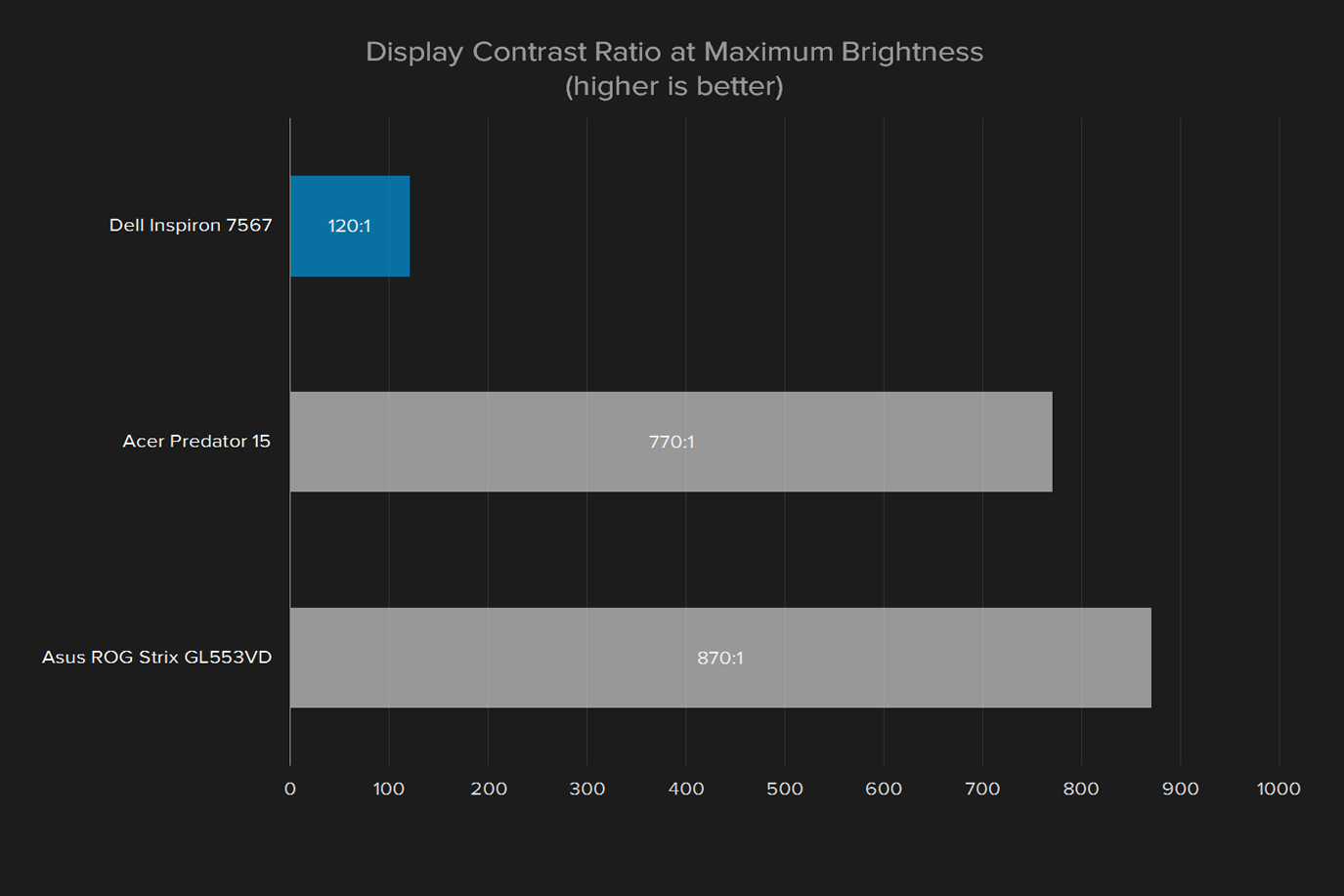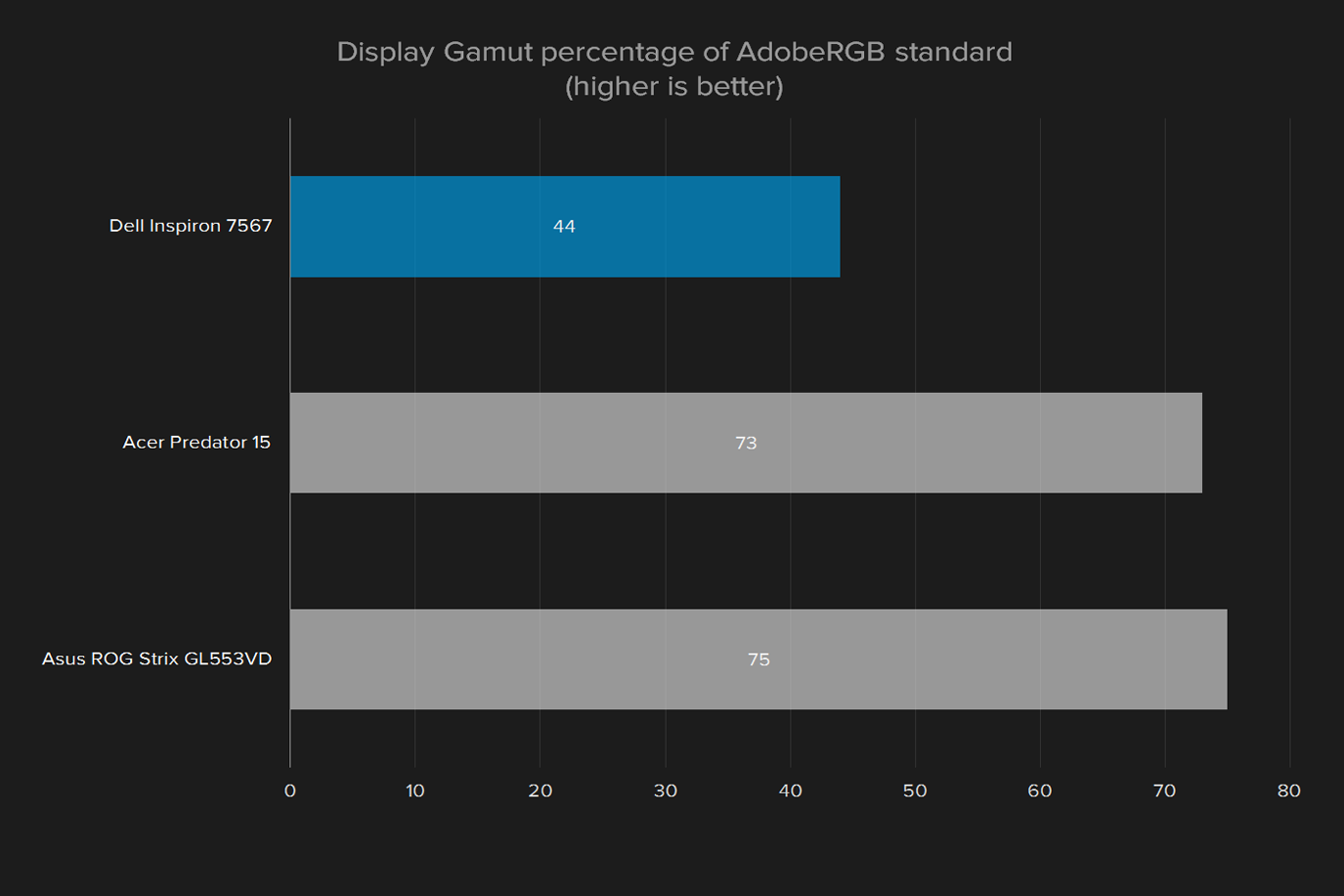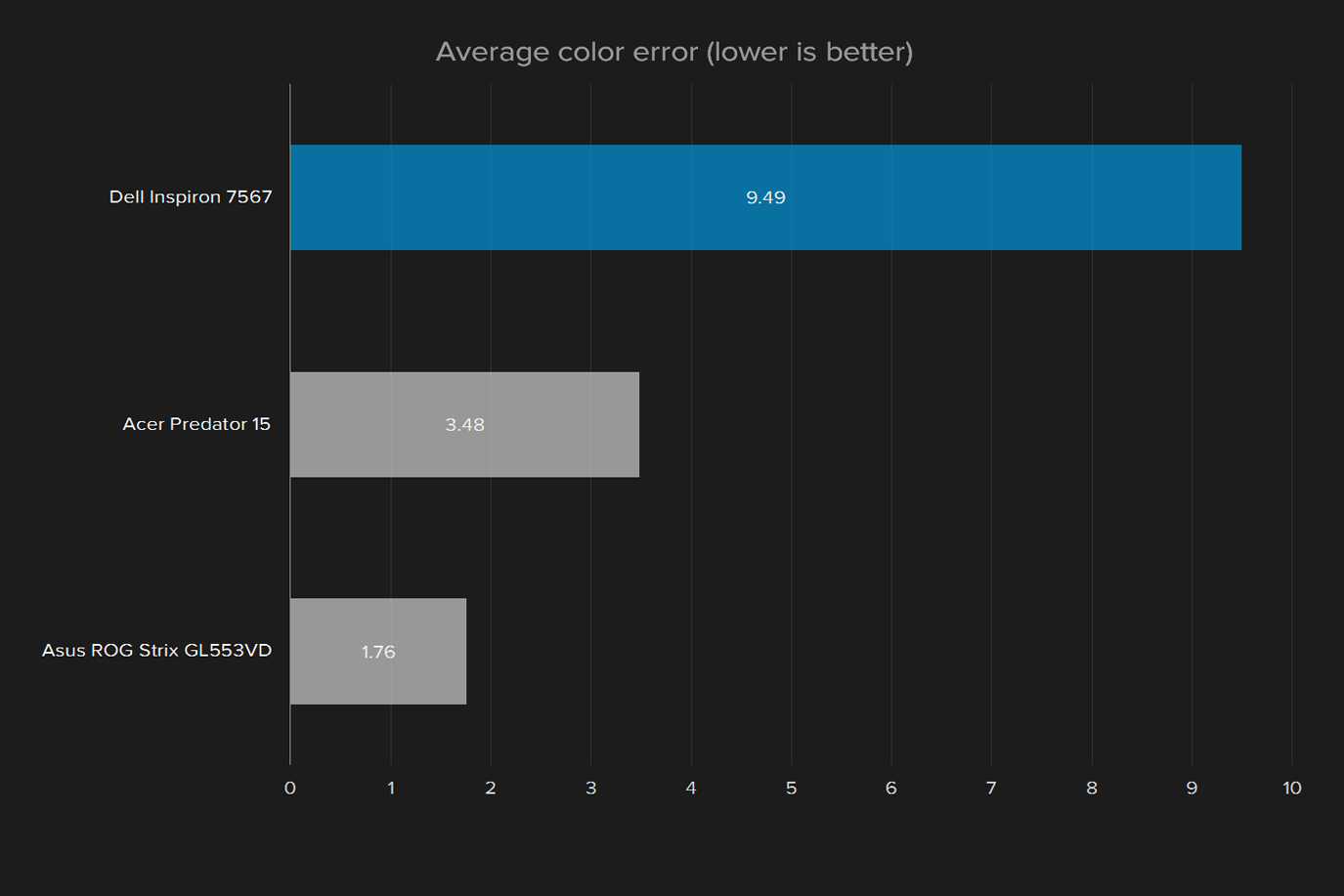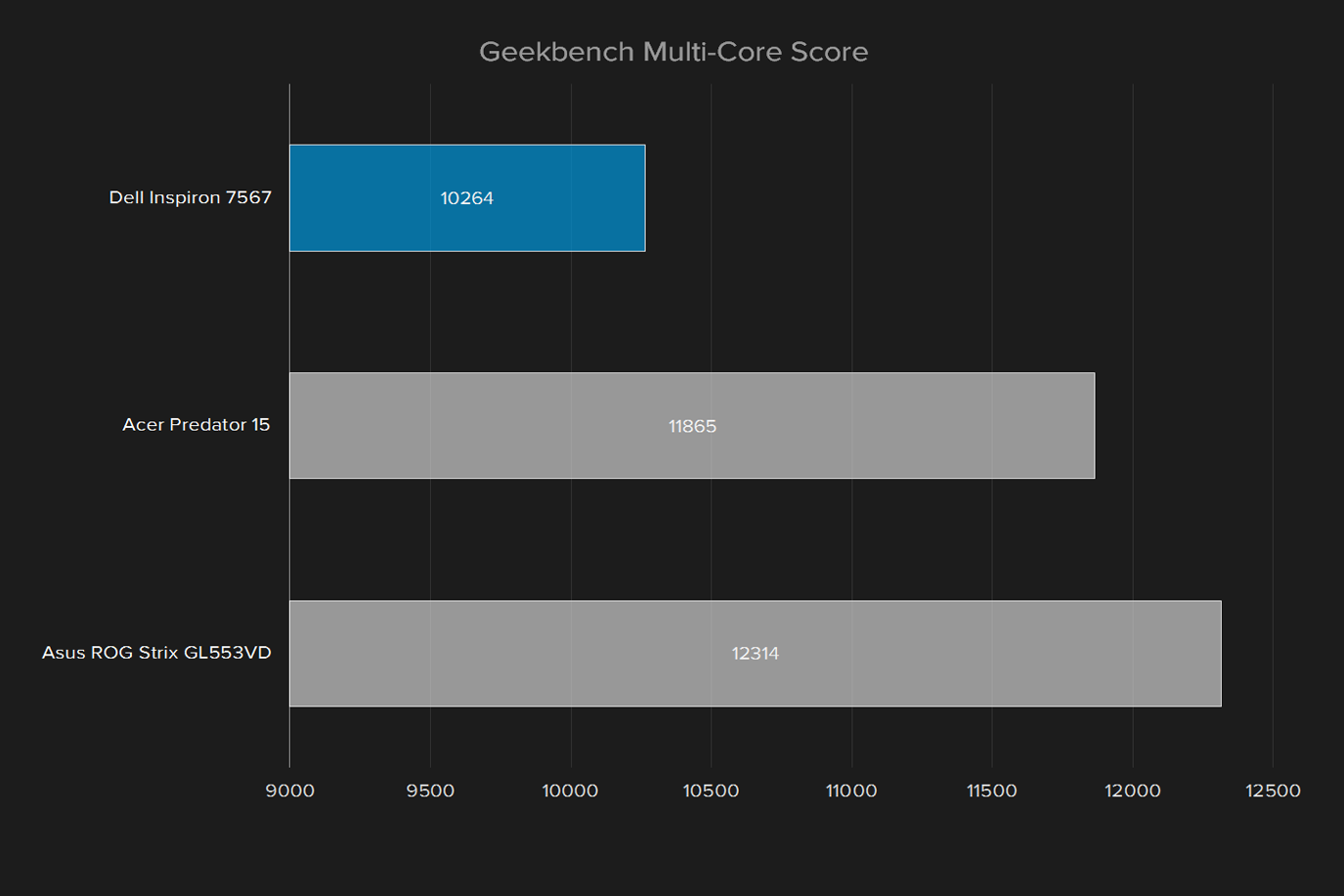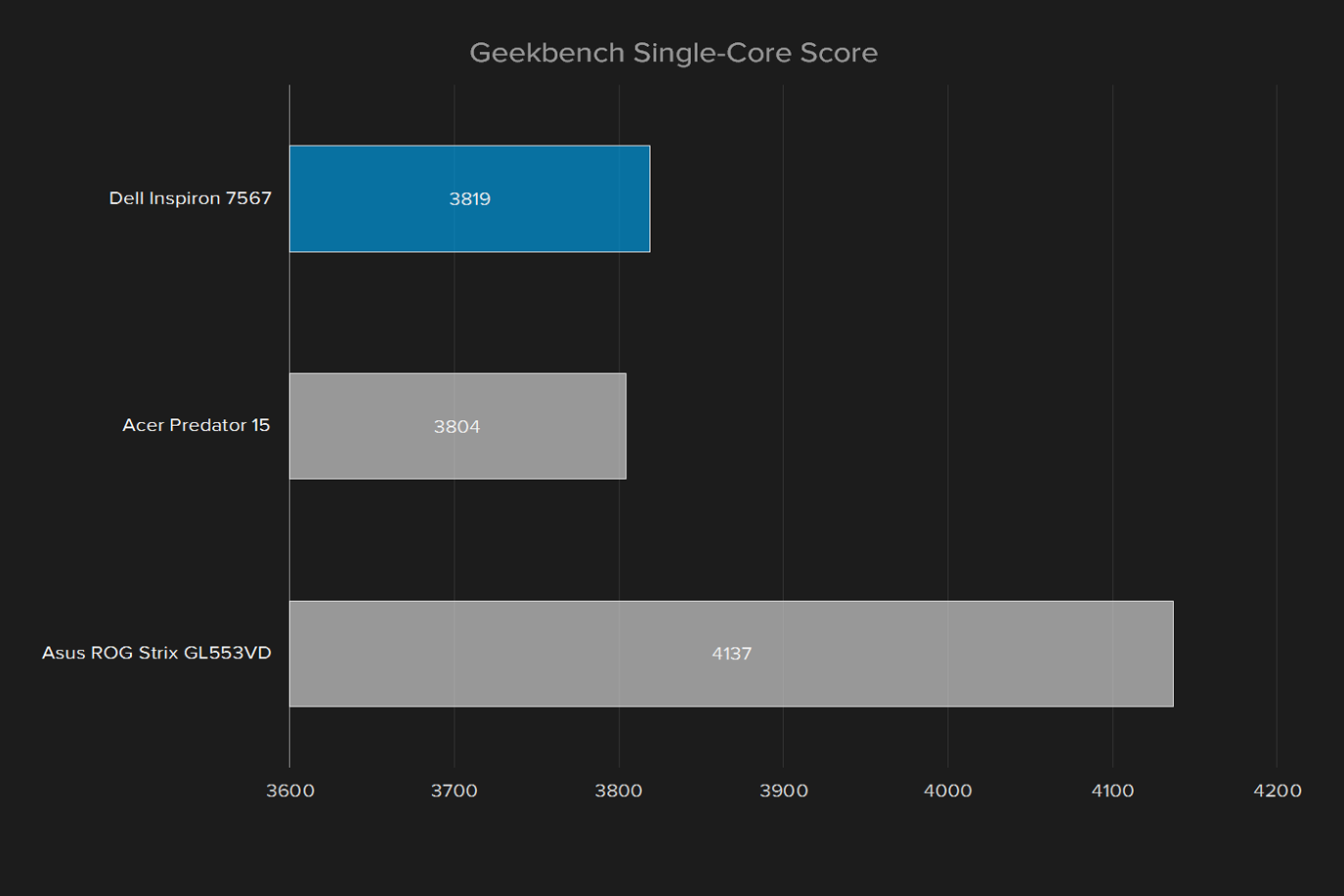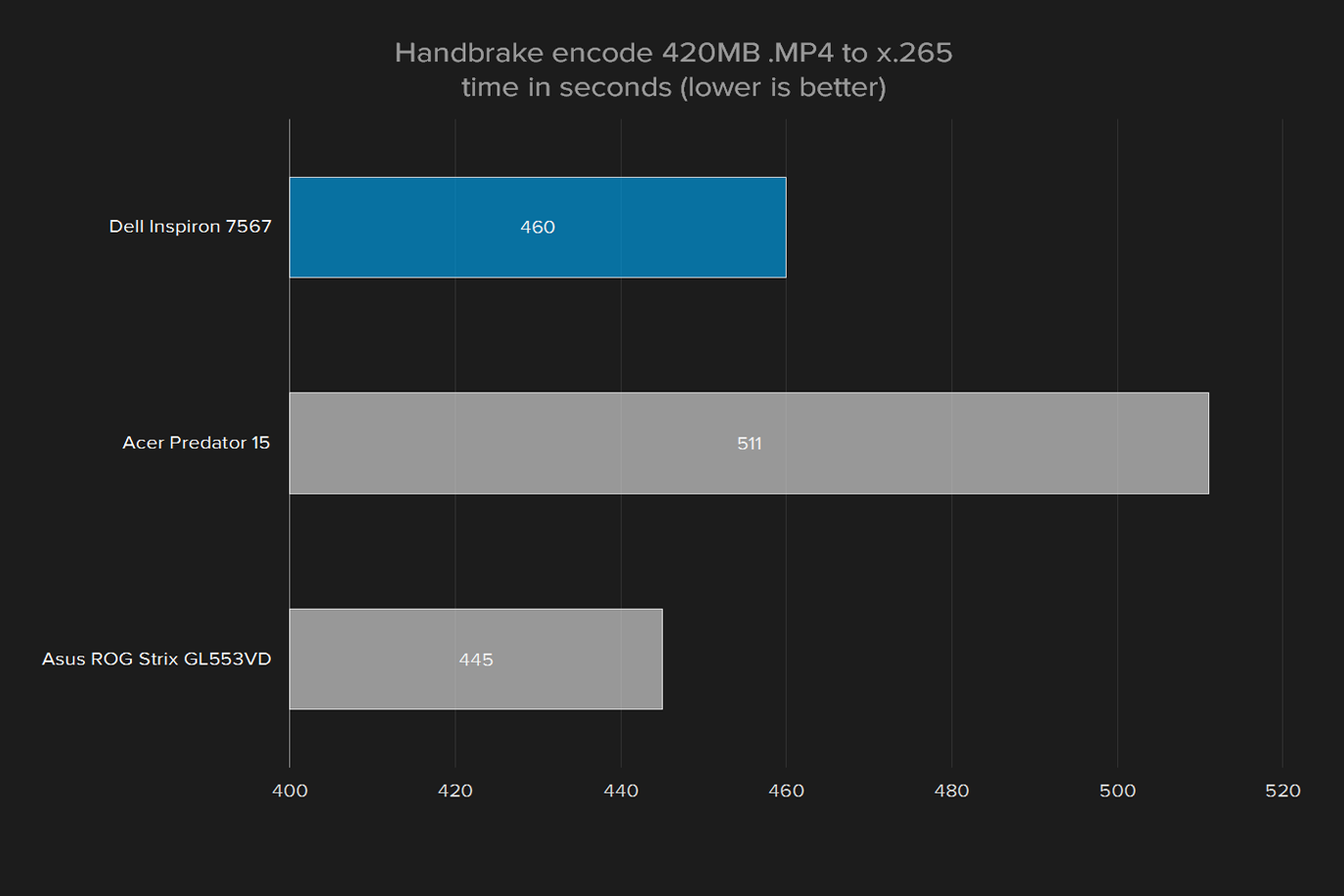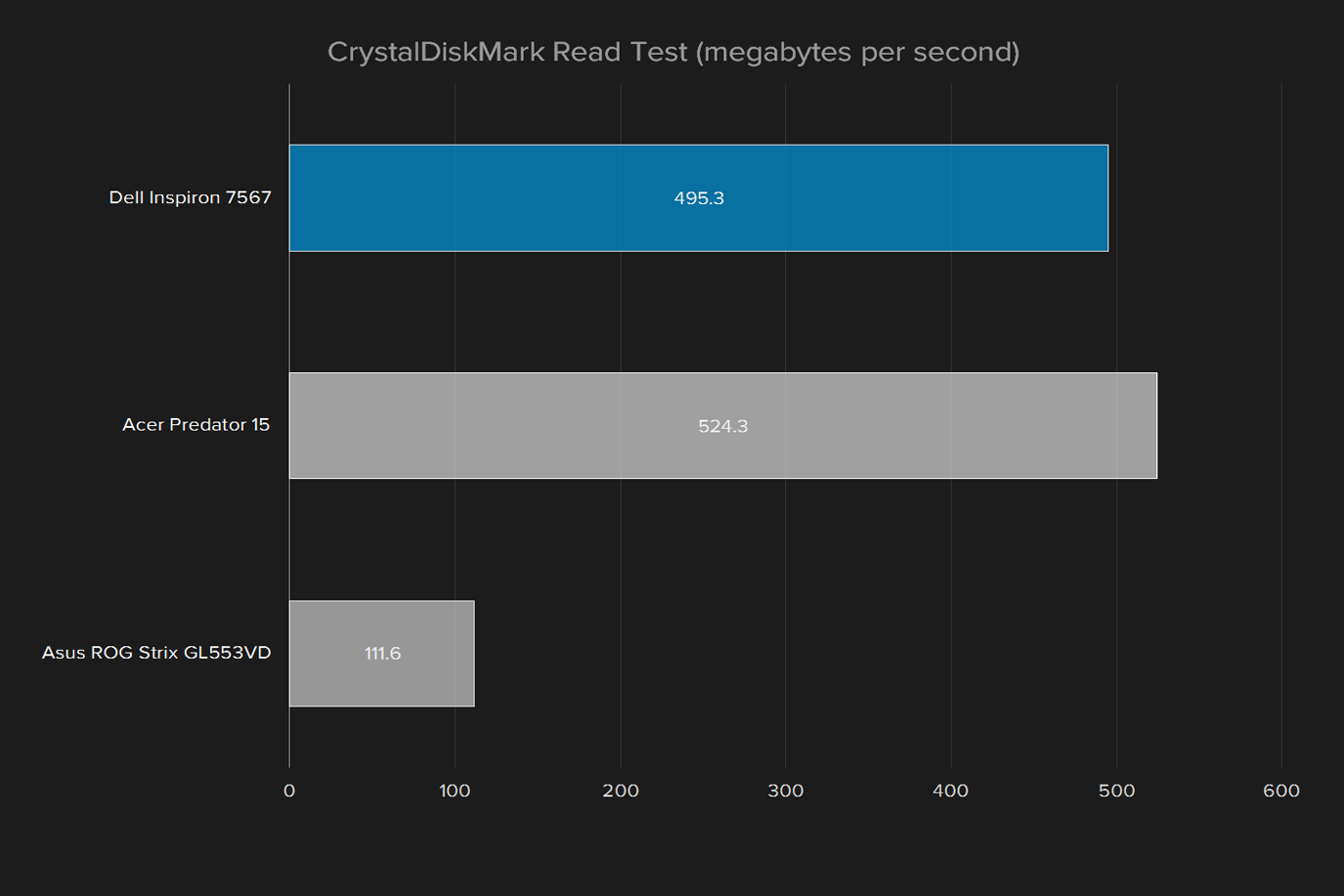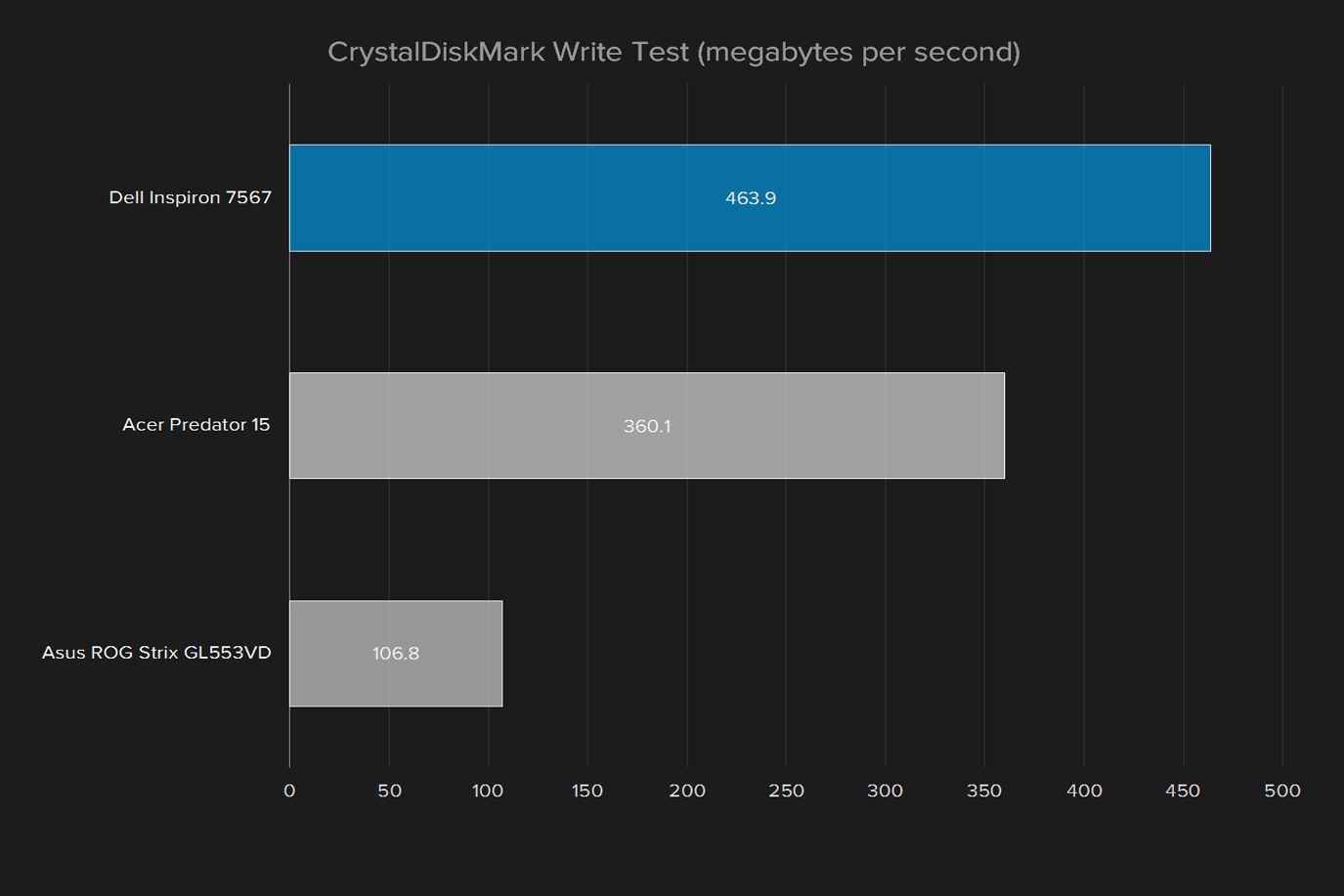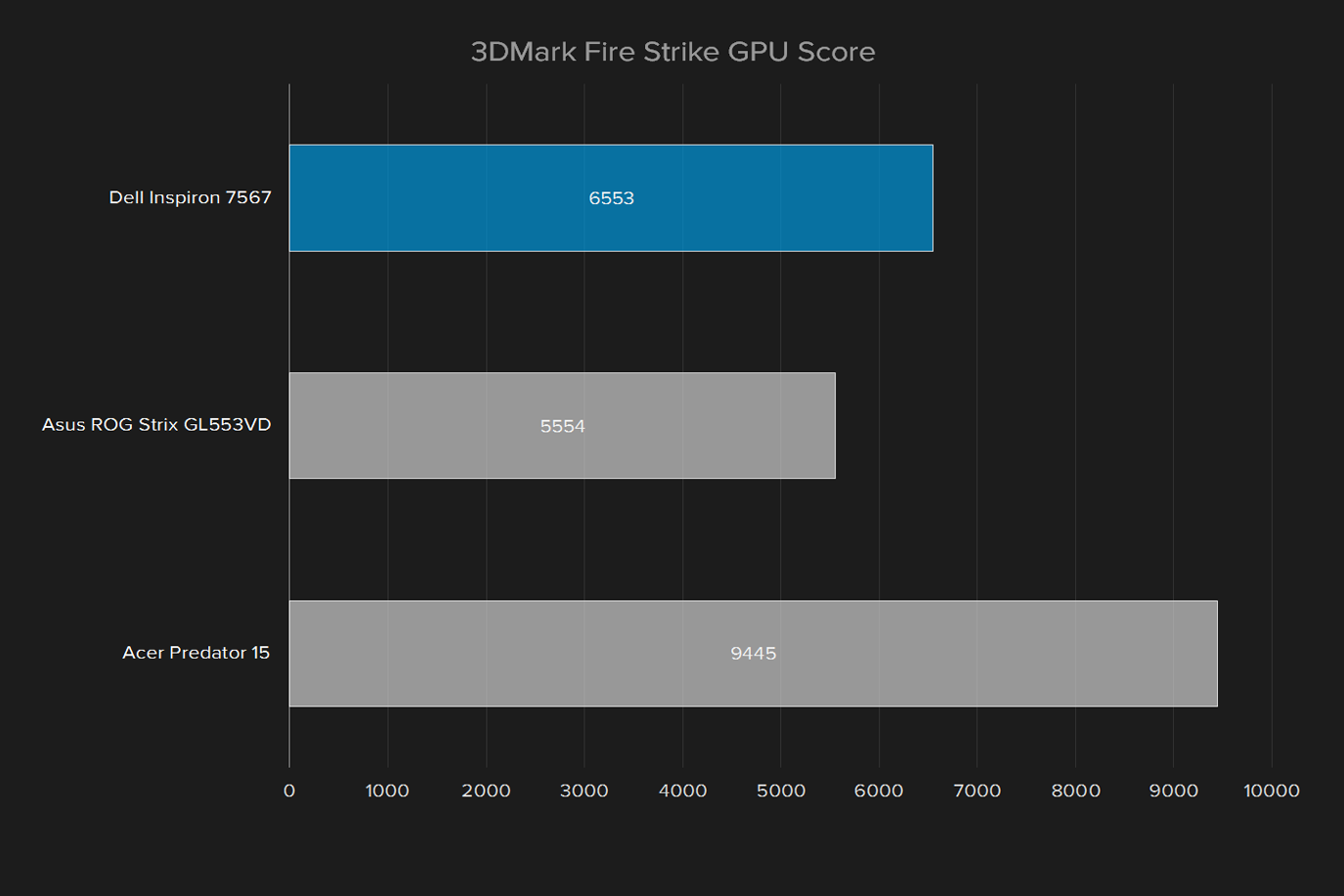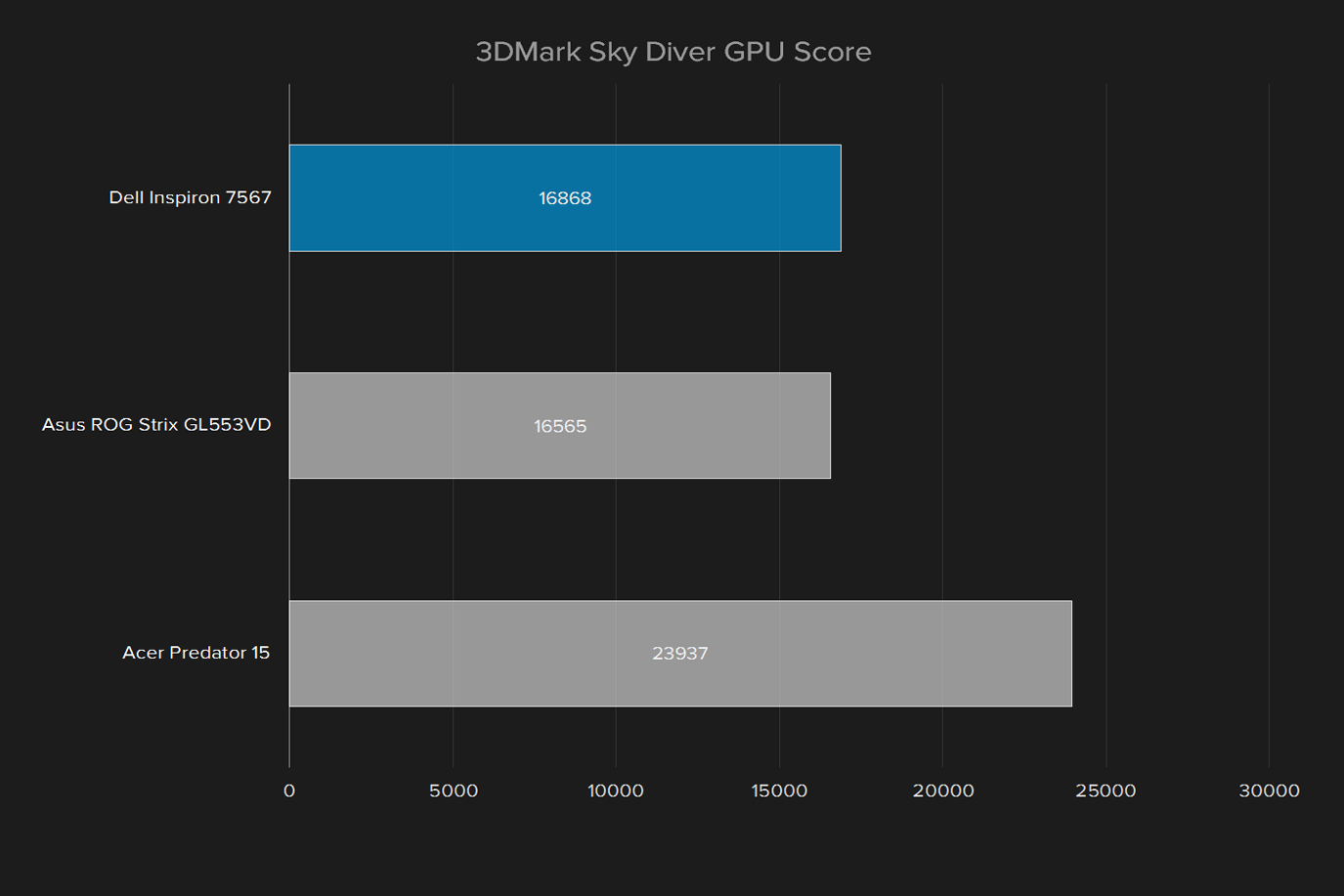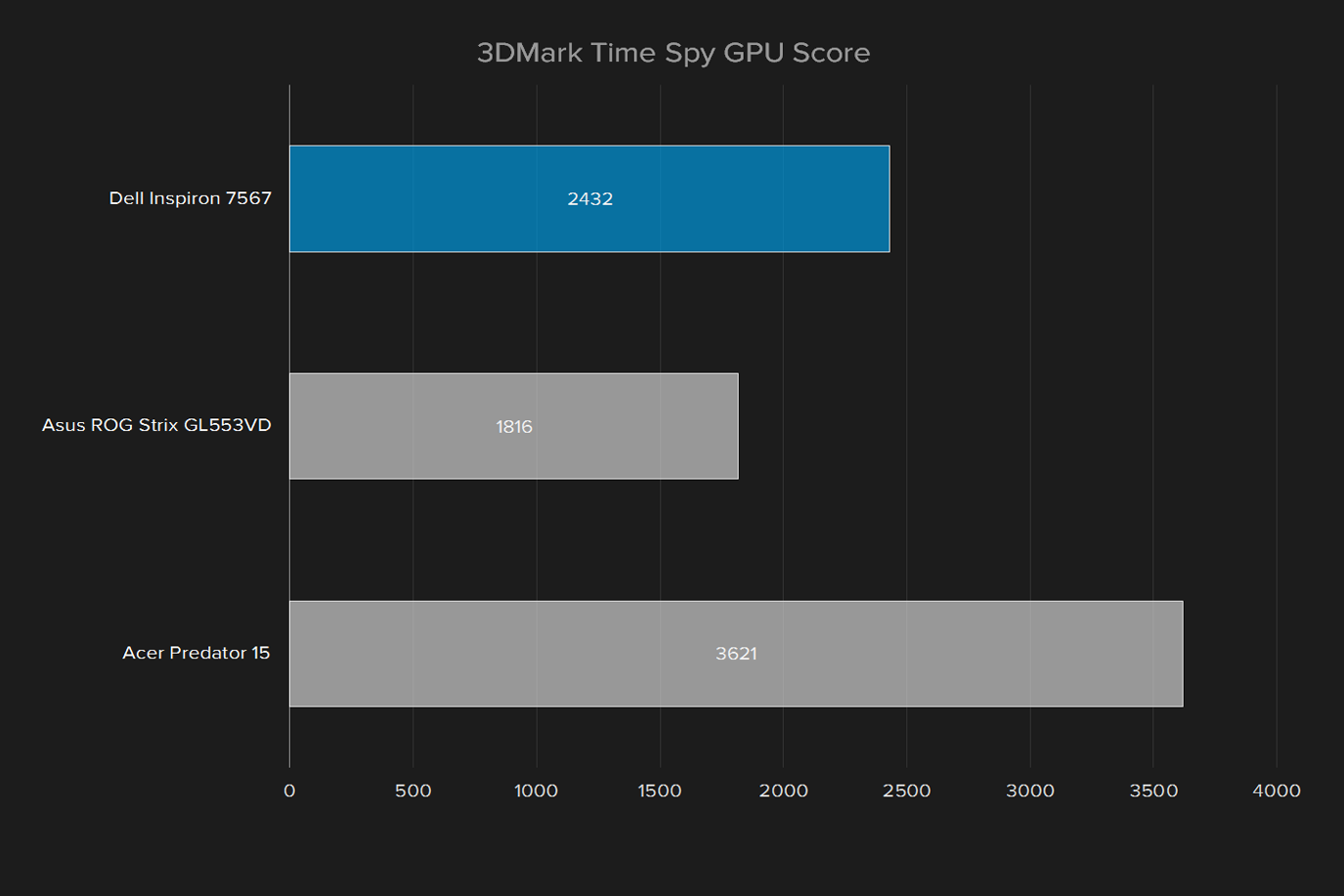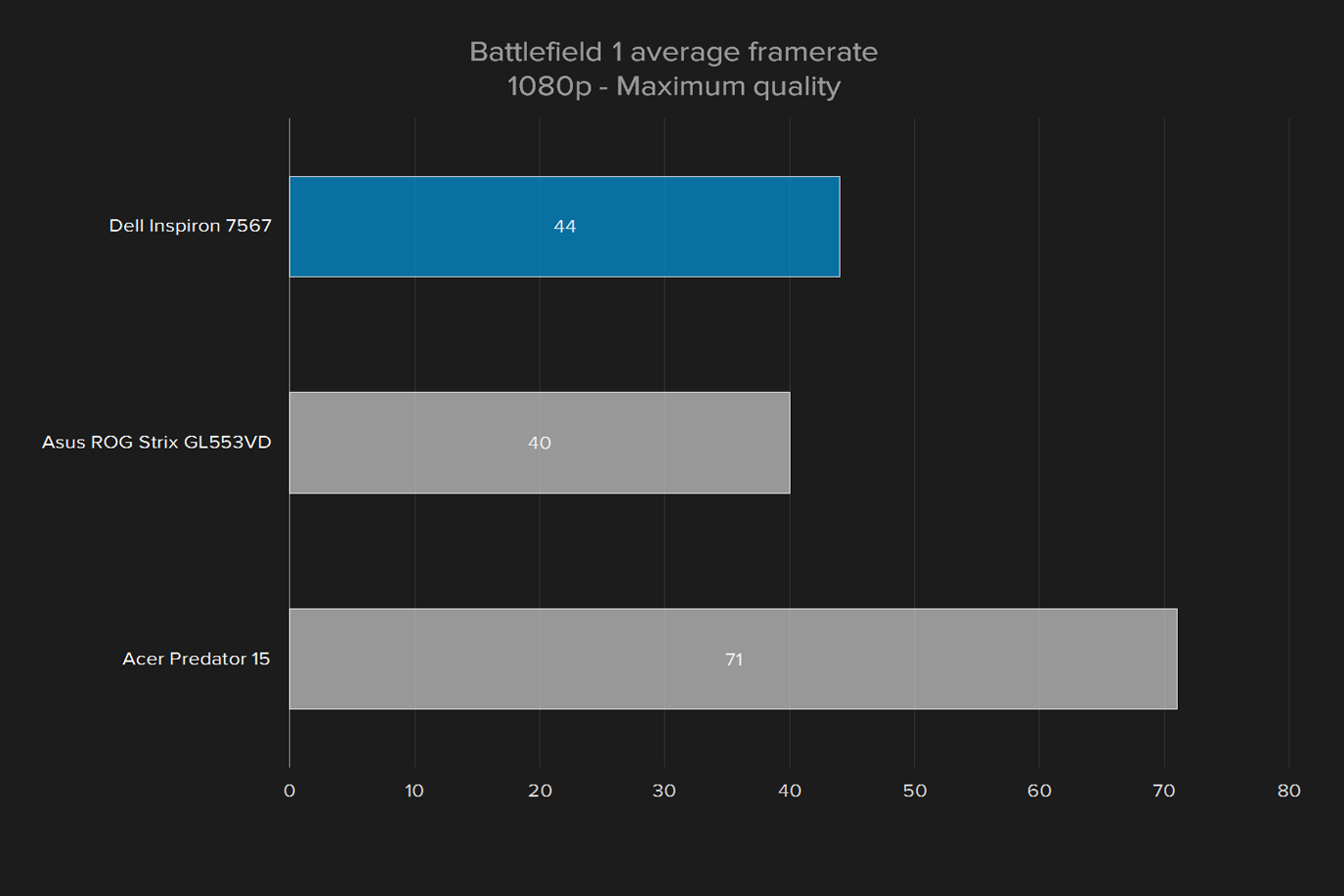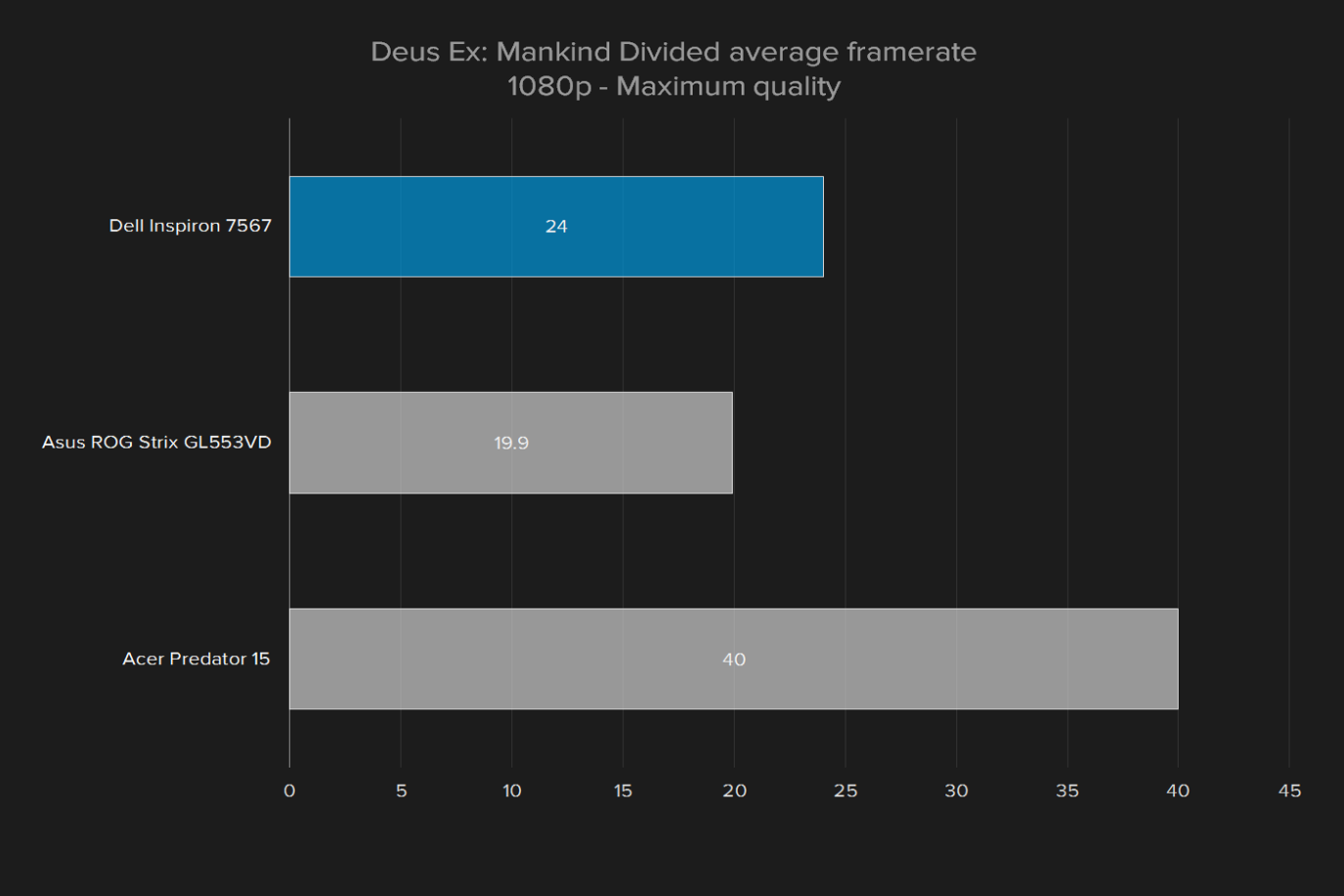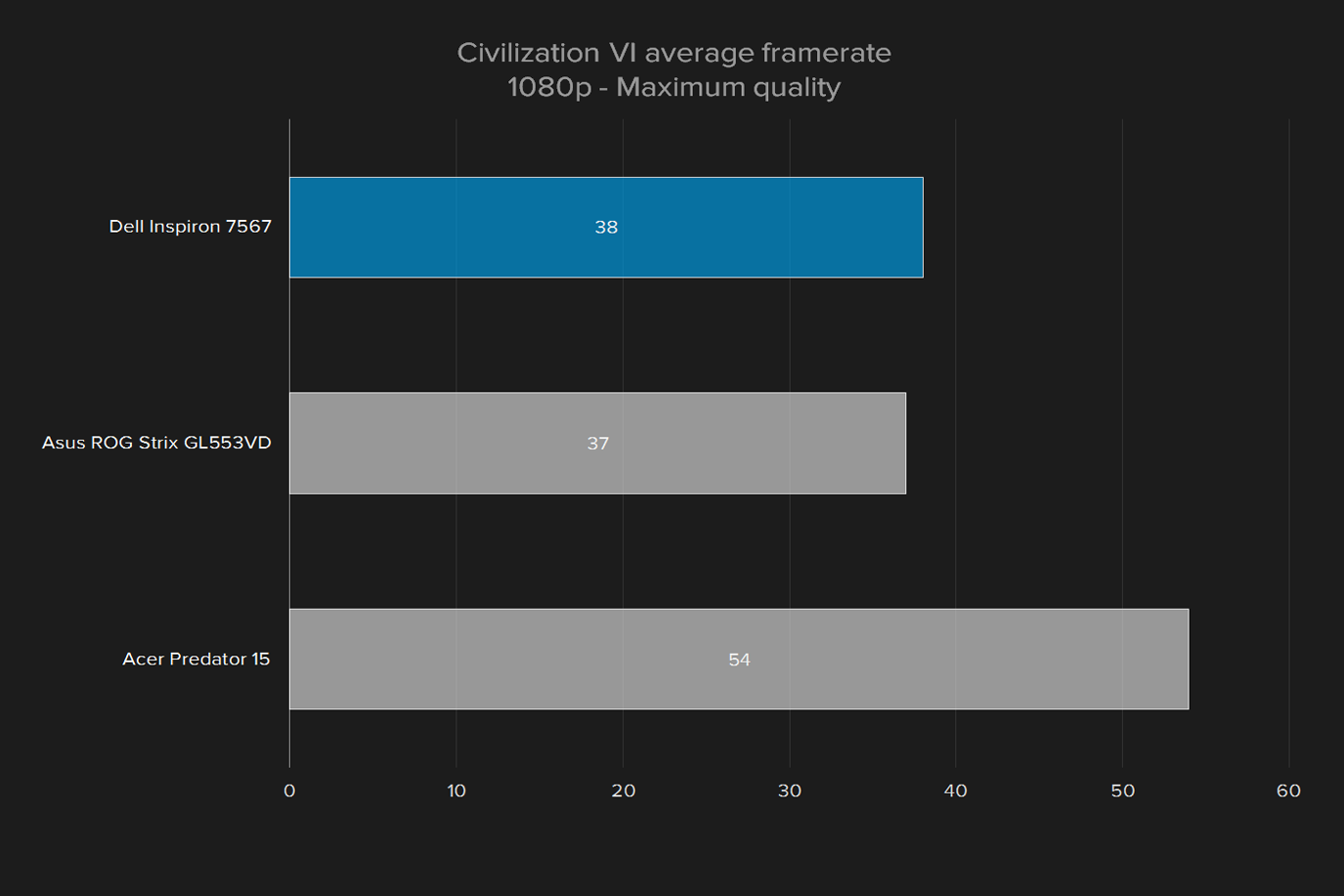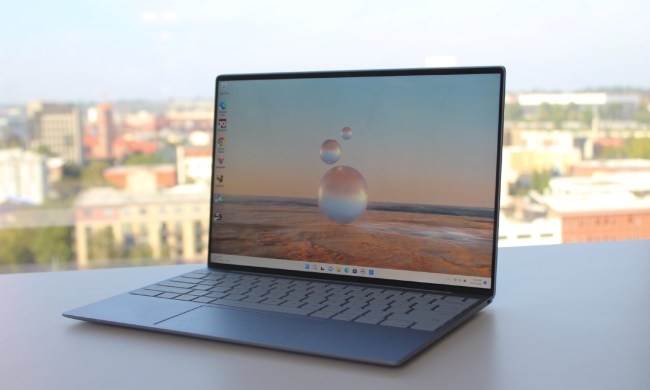“The Inspiron 15 Gaming manages to look both better and worse than its predecessor.”
- Solid value
- Attractive design
- Good battery life
- Extraordinarily poor color gamut
- High color error
- Poor viewing angle
- Flimsy keyboard
Gaming notebooks are notoriously expensive, to the point that spending anything less than $1,200 for a low-end machine is a rarity. That’s why we were so impressed by Dell’s Inspiron 7500 in late 2015. It was a capable gaming notebook in a compact package, all for about $800. It was a pleasant surprise, and undercut the competition by a significant margin.
Dell sought to build on that legacy with this year’s model, the Inspiron 15 Gaming. It boasts a 7th-generation Intel Core i5 processor, an Nvidia GeForce GTX 1050 Ti GPU, and comes in an attractive new chassis. At first glance, it looks like it would run circles around the 2015 model, but you might be surprised by some of our test results.
Slick and professional
This laptop is a real looker. It features a sleek, professional design which manages to effortlessly blend form and function. The front-side features a speaker grille with a beveled angle, the back-side features a similar grille pattern over the massive exhaust vents, beveled at an opposing angle for a unique take on the classic notebook silhouette.
The Dell Inspiron 15 Gaming’s design is all at once stylish, modern, and playful. Unlike the previous late-2015 model, Dell went all-in on the black-and-red design. By kicking the white LED keyboard backlighting to the curb and ditching the almost shy, dull red accents featured on the earlier model in favor of rich, candy apple red design elements, Dell has created a truly unique and striking laptop.
This is a design that seamlessly bridges the gap between the design language of professional workstations and an off-hours LED-bedazzled gaming powerhouses. It’s just striking enough to stand out, without feeling out of place in more professional situations.
Missed connections
Let’s talk about ports. They’re never the kind of headline feature that you would see touted prominently in celebrity ad campaigns, but they’re very important. In fact, they might be more important than ever, since we’re currently in a period of transition between the old standby, USB Type-A, and the somewhat troublesome newcomer, USB Type-C.
So, it’s a little disappointing that the Inspiron 15 Gaming doesn’t include even a single USB Type-C port. Still, it does feature three traditional, USB Type-A, ports, an Ethernet port, an HDMI 2.0 port, a 3.5mm headphone jack, and an SD Card slot. They’re evenly distributed on the left and right sides of the laptop, and frankly they feel a little lonely. There’s a lot of space here, and it feels like it should be put to better use.
Gritty, and not in a good way
No matter your keyboard preferences, you’re likely to be disappointed by the Inspiron 15 Gaming’s flimsy plastic keys. The keys themselves are matte plastic, and they feel oddly gritty and cheap. Imagine if someone made a keyboard out of those plastic fast-food soda lids, and you get the idea.
To say that this display has problematic color accuracy is a vast understatement.
The LED backlighting is a nice touch, Dell wisely chose to adopt a deep-red backlight which fits with the overall aesthetic of the keyboard. The lighting shines through the key caps, and under the edges for a pleasant but not overbearing effect. The backlighting here isn’t RGB, it’s just R, there’s no way to change the color – but it does feature three brightness settings, bright, dim, and off.
It looks nice, but doesn’t feel that way. Which is a shame because the trackpad is a huge improvement over the previous model. The 2015 Inspiron 7500 featured a matte trackpad that only seemed to have two sensitivity settings: way too high, and way too low. It was an inaccurate and generally awful trackpad, but that’s one compromise you can get away with on a budget system, so it wasn’t a dealbreaker.
The Inspiron 15 Gaming ups its game significantly, offering a smooth and silky trackpad that is laser-accurate and never fails to go exactly where you want it to. Adjusting sensitivity settings can tune the trackpad to your liking, and even on the highest and lowest settings the trackpad never loses that unerring accuracy.
The display is a huge disappointment
When you’re purchasing a laptop, particularly a gaming laptop, every component is important. Unlike a desktop PC, you’re essentially buying a static platform. Problems are harder to fix, because you can’t just swap out a new CPU, or GPU, and for most users, swapping out a display is just as difficult — if not impossible. It’s not an ideal solution, but it’s something a few Inspiron 15 Gaming users have resorted to after realizing the poor quality of the included TN display panel.
When you’re talking about display performance, you’re usually splitting hairs — looking at contrast ratios that differ by very small margins, color error figures that are less-than-perfect, but still very good. That is not the case with the Inspiron 15 Gaming. This display’s poor quality is immediately noticeable. Colors are way off, everything is tinted blue, and if you vary your viewing angle by even a few inches, the entire screen becomes washed out.
Everything is cast in a bruised purple-blue pallor, whites are too bright, and darks are dim and gray. Such a poor contrast ratio coupled with awful color accuracy means that everything has a flat quality that just sucks the life out of photos, and movies.
The display even made playing games difficult to stomach. In Deus Ex: Mankind Divided for instance, we had to constantly push the screen forward and back to try and find the narrow “sweet spot” to diminish the discoloration caused by non-optimal viewing angles.
Poor viewing angles and discoloration are par for the course when it comes to inexpensive twisted nematic, or TN, LCD displays. These panels are among the most common LCD panels on the market thanks to their cheap manufacturing cost. TN panels typically have slightly better response times than other types of display panels, but they’re based on technology pioneered in the 1980s and their ability to fully resolve all 16.2 million colors available from modern GPUs tends to remain limited.
Unfortunately for the Inspiron 15 Gaming, the numbers only confirm what our eyes were telling us. This display doesn’t stack up to its nearest competitors in any way.
With a contrast ratio of 120:1, the Dell Inspiron 15 Gaming has about one tenth the display performance of a smart phone. Its average color error is massive at 9.40, meaning your colors are always going to be off, shifted heavily toward the blue end of the spectrum.
For comparison, the Acer Predator 15 managed an average color error of 3.48. It’s not a great score, and it would be cause for concern if you were looking at purchasing that notebook. Colors were a little off, barely noticeable to the naked eye, but just enough to be problematic if color accuracy was an important part of your workflow.
The Inspiron 15 Gaming is three times worse when it comes to color reproduction. To say that this display has problematic color accuracy is a vast understatement.
With that in mind, it’s no surprise that the color gamut is way off. Revisiting the Predator and Strix, they both reproduce over 70 percent of the finicky AdobeRGB scale. Most monitors land somewhere between 70 and 75 percent but the Inspiron 15 Gaming falls well below that standard.
The Inspiron 15 Gaming is three times worse when it comes to color reproduction.
The TN panel on the Inspiron 15 Gaming is only capable of reproducing 44 percent of the AdobeRGB scale. This laptop can only reproduce about half the colors most monitors can — and even that small spectrum of colors is going to be wildly inaccurate.
These results are so bad you might think them a mistake. They’re not. We have witnessed similar performance in the past, when TN panels were actually rather common in laptops. They’re not anymore, so we generally don’t see displays this bad.
We spoke to Dell about its decision to go with this display. The company was adamant that this decision was the only way to upgrade the internal hardware without increasing the price. We understand the pressure to keep the price low, but in case, too great a sacrifice was required. Improved internal hardware is useless if the display used to enjoy it looks awful.
7th-generation gains
Let’s step away from the display issues and dig into the Inspiron 15 Gaming’s CPU performance. Outfitted with an Intel Core i5-7300HQ clocked at 2.5GHz, the Inspiron is very quick on its feet. Even when working with a second monitor and running a dozen demanding applications all at once, the Inspiron’s 7th-generation Intel CPU kept up beautifully.
As you can see, the Inspiron 15 Gaming is capable of keeping pace with systems that cost hundreds of dollars more, and only loses significant ground to the Core i7-7600HQ in the Asus ROG Strix.
Perhaps most importantly, what you can see in our results here is a progression in performance from Intel’s 6th-generation chips to their current 7th-generation lineup. The Acer Predator 15 features a 6th-generation Core i7-6700HQ, a fast quad-core CPU clocked at 2.6GHz, while the Asus ROG Strix features a 7th-generation Core i7-7600HQ, essentially a current-gen version of the Acer’s chip.
There’s a substantial performance gulf between these two chips, and the Asus leads the pack and easily eclipses the CPU performance of the Acer. But what do we have right in the middle? The Inspiron 15 Gaming and its 7th-generation Intel Core i5-7300HQ. This is a CPU that has a lower clock speed than the Acer Predator 15, but manages to perform just as well in most of our tests.
This is a massive step backward for an otherwise impressive product line.
The 6th-generation i7 in the Acer Predator 15 features hyper-threading and a slightly larger cache, meaning it’s a bit better than the Inspiron’s 7th-gen i5 chip, when it comes to handling multiple CPU-intensive applications at once. The i7’s hyper-threading allows it to use its four cores to essentially emulate an eight-core chip, and pump out better multi-tasking performance. The 7th-generation i5, on the other hand just has four traditional cores and doesn’t feature hyper-threading.
Without getting too into the weeds about the differences between i5 and i7 chips, what we’re seeing here is that the Inspiron 15 Gaming’s current-gen Intel Core i5 works nearly as well as the Acer’s previous-gen i7 chip, with slightly less power, but the i7 is still a more capable, all-around CPU.
Small but quick
The Inspiron 15 Gaming isn’t exactly spacious when it comes to hard disk storage, but the included 256GB SSD performs well, if not spectacularly, when compared to its nearest competitors. Like most modern notebooks, you can opt to include a 1TB hard disk when you’re putting it together on the manufacturer’s website, but raw storage isn’t quite as important as speed.
Hitting 463 megabytes-per-second in our write test, the Inspiron’s SSD proves it’s not going to slow you down when you’re moving big files around. In the read test, it managed 495.3 mbps, and fell a bit behind the Acer Predator 15’s 256 SSD, but remained well ahead of the Asus ROG Strix and its 1TB HDD.
The Inspiron’s included 256 SSD isn’t the biggest out there, but for the price it’s a good little drive, and in our tests it never choked or slowed things down even when we were installing games or moving around huge files. It’s not as fast as some, and it’s not as big as others, but it gets the job done.
Ti-ed up
Nvidia’s 10-series graphics cards are generally quick and powerful, with GeForce GTX 1080s at the very top of the price and performance spectrum, and GTX 1050s toward the bottom. The Inspiron 15 Gaming is outfitted with a GTX 1050 Ti graphics card, with 4GB of RAM.
It’s a budget card, and it’s no surprise to see it in what is ostensibly a budget notebook, but as we’ve seen in some of our other reviews, the 1050 Ti doesn’t quite perform well enough to get the most out of modern games.
Looking at our performance results, the Asus ROG Strix makes an interesting comparison for the Inspiron 15 Gaming. The Strix features a 6GB GTX 1050, where the Inspiron features a 4GB 1050 Ti.
Naturally, you’d think the Strix would perform better with a little extra memory, right? Well, that’s half right. The Inspiron features a GTX 1050 Ti, which is sort of the “pro” version of the GTX 1050. The 1050 Ti is capable of pumping out 2.1 TFLOPs of data, to the 1050’s 1.8, and it features a slightly higher number of CUDA cores – 768 to the 1050’s 640.
All in all, what it means is that both cards are within striking distance of each other, but the 1050 Ti is a little more capable, and even with less video RAM it’s a formidable match for the GTX 1050 in the Asus ROG Strix.
The Inspiron’s 1050 Ti offers a small performance boost across the board, pushing just a hair past the Strix in Battlefield 1, Deus Ex: Mankind Divided, and Civilization VI.
Still, you can see that the Acer Predator 15 with its Nvidia GeForce GTX 1060 easily outperforms both the Inspiron and the Strix by a sizable margin, and the 1060 is only one rung up the price and performance ladder.
Formal benchmarks in 3DMark illustrate just how wide that performance gap really is. The Predator’s GTX 1060 easily eclipses the GTX 1050 and 1050 Ti in every one of our benchmarks. The results here are instructive for any potential gaming laptop customers out there:
Lightweight longevity
Just Google “gaming laptop” and you’ll be presented with a tableau of LED-bedecked notebooks, many of which are as light and portable as a sack of bricks. Luckily, Dell has decided to buck this trend with the Inspiron 15 Gaming, weighing in at just 5.76 pounds. That might sound heavy for a laptop, in this era of ultra-light-ultra-thin netbooks, but for a gaming laptop it’s downright svelte.
By comparison, the Acer Predator 15 weighs 8.6 pounds — and speaking from experience, that’s a very heavy laptop to carry around all day. The Asus ROG Strix is a little lighter, at 5.5 pounds, but both the Strix and the Inspiron are well within the “goldilocks zone” when it comes to weight.
Nvidia’s 10-series graphics cards are generally quick and powerful.
Battery life on the Inspiron was a pleasant surprise. Even with a power-hungry GTX 1050 Ti purring away under the hood, the Inspiron managed to consistently provide between four and five hours of battery life in most of our tests. The Peacekeeper browser test drained the battery in a little under four hours, but our video loop and web browsing macro tests remained between four and five hours each.
Looking the Asus ROG Strix and the Acer Predator 15, the Strix barely managed two hours on the Peacekeeper browser test, and the Predator 15 managed just over two and a half hours. The Inspiron is the clear winner here, providing all-around battery life well in excess of its nearest competitors.
Anecdotally, you can expect about five or six hours of battery life during an average day of mixed-use (if that mixture doesn’t include any gaming). It’s not quite long enough to last an entire workday, but long enough for on-and-off usage or an afternoon away from the office. Just turn off the keyboard backlighting and turn the display brightness way down.
Useful utilities
Thankfully the Inspiron doesn’t include very much manufacturer bloatware, just the usual Dell-branded utilities like a registration tool, system information, and a display calibration tool. If you end up buying an Inspiron 15 make sure you get familiar with that last tool, it can’t make up for the terrible TN panel, but you can at least rebalance your colors so everything is a little less purple.
Warranty information
The Dell Inspiron 15 Gaming comes with a standard one-year warranty against manufacturer defects including a 90-day warranty for any individual Dell-branded spare parts you purchase for the Inspiron. There’s nothing out of the ordinary here, it’s the same warranty that covers most Dell products.
Our Take
Close your eyes and the Inspiron 15 Gaming is a resounding success. Plug in an external monitor and it stands on its own and as a worthy successor to the 7500 as a gaming laptop with just enough horsepower for most modern games. Are you sensing a theme here? The hardware in the Inspiron 15 is solid, reliable, and powerful enough to make the $950 price tag seem very reasonable, but the display is so demonstrably, mathematically poor that it’s very difficult to recommend.
Is there a better alternative?
Yes, there are better alternatives out there. The Asus ROG Strix has some eccentricities, including its own display abnormalities, but at $1100, it’s very close to the same price range as the Inspiron and its display is much, much better. On the other end of the spectrum, the Acer Predator 15 outperforms the Inspiron in nearly every way, and it starts at $1500. But at that price point, there are a lot of competitors out there, and almost all of them provide better quality displays than the Inspiron 15 Gaming.
How long will it last?
It would be easy to rag on that atrocious TN display panel and say it probably won’t last very long since its already washed out, but there’s another concern here: the GTX 1050 Ti. As we mentioned previously, the GPU just doesn’t give you enough performance headroom to get the most out of modern games.
If it can barely run 2015’s games at max settings today, how well will it fare against games a year from now? Two years from now? The GTX 1050 Ti just doesn’t have enough horsepower to lend the Inspiron 15 Gaming any amount of real longevity. You’d be better off saving up and getting a notebook with a GTX 1060, or GTX 1070 a few months down the line.
Should you buy it?
No. Considering all the mitigating factors — a low price, very attractive design, fast hard drive, and good battery life — there is just nothing this notebook does that can make up for the unbelievably poor display panel. It doesn’t render nearly enough of stock-standard color spectra, and the parts that it can reproduce, it does so poorly with a high degree of inaccuracy. Despite all the factors working in its favor, the Inspiron 15 Gaming’s display makes it impossible to recommend.





